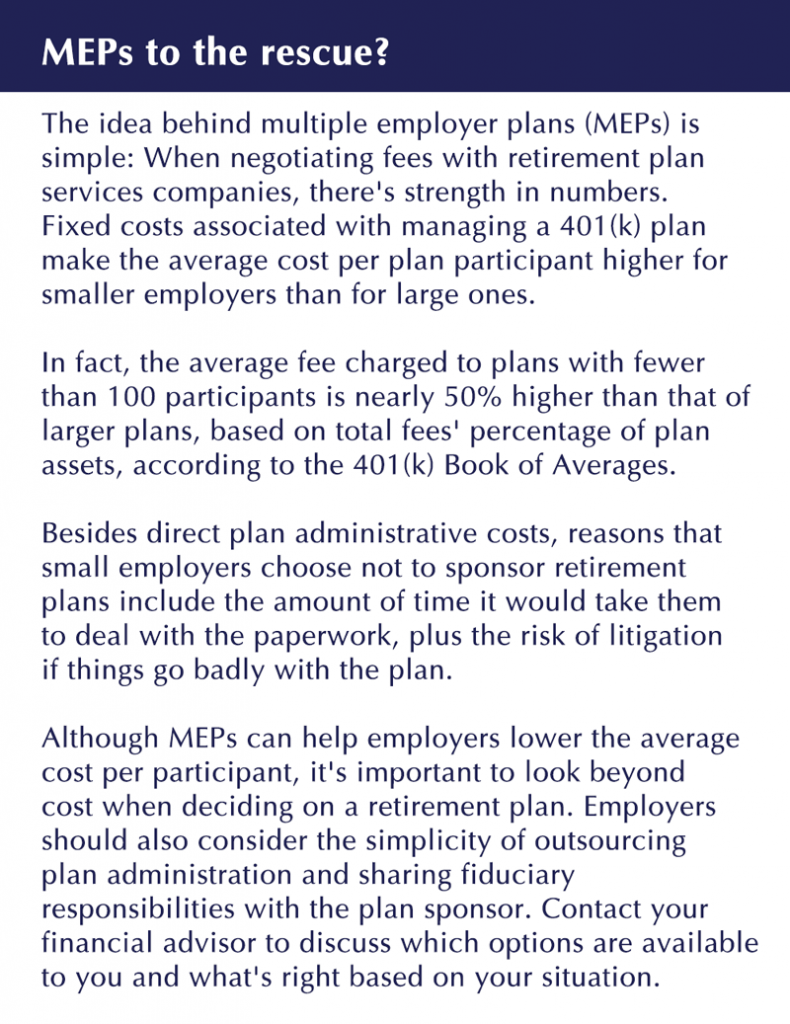A new final rule from the U.S. Department of Labor (DOL) clarifies some of the ins and outs of multiple employer plans (MEPs). These are defined contribution retirement plans—such as 401(k) plans—that are sponsored by an association or employer group on behalf of member employers.
Clarifying the Rules
Existing DOL rules already allow MEPs to exist. And the new rule, which goes into effect on September 30, 2019, was designed to “clarify and expand the circumstances under which U.S. employers … may sponsor or adopt [MEPs].”
Among other requirements, groups and associations of employers that sponsor MEPs can have as members either:
• A group of local businesses (for example, a chamber of commerce), or
• An association of businesses within the same industry, regardless of location.
PEO Guidance
The most significant feature of the new rule is its roadmap for professional employer organizations (PEOs) to sponsor MEPs. PEOs assume the primary legal obligations of an employer, then lease its employees to companies that put them to work under contract with the PEO.
The final rule differs from the proposed version with respect to a PEO’s eligibility to sponsor MEPs. Specifically, the regulations provide a four-part “safe harbor” test.
1. The PEO is responsible for paying wages to employees, without regard to the receipt or adequacy of payment from those clients.
2. The PEO takes responsibility to pay and perform reporting and withholding for all applicable federal employment taxes, without regard to the receipt or adequacy of payment from those clients.
3. The PEO plays a definite and contractually specified role in recruiting, hiring and firing workers, in addition to the client-employer’s responsibility for recruiting, hiring and firing workers.
4. The PEO assumes responsibility for, and have substantial control over, the functions and activities of any employee benefit that the PEO is contractually required to provide, without regard to the receipt or adequacy of payment from those client employers for such benefits.
The tests are designed to ensure that a company representing itself as a PEO acts as a bona fide employer, and bears responsibility for employee benefits, including a MEP-style plan.
Open MEPs
The new rule does not include a provision that would allow an association to open its membership to businesses of any industry sector in any part of the country to join. Such an entity would be called an “open MEP” or a “pooled employer plan.” Instead, the final DOL rule asks stakeholders to offer their ideas on several regulatory questions around open MEPs. Responses are due by October 29.
A new federal law would be needed to throw open the gates to open MEPs. In fact, proposed legislation—the Setting Every Community Up for Retirement and Enhancement (SECURE) Act—facilitating open MEPs passed in the House in May 2019. But opposition has held the bill back so far in the Senate.
Fiduciary Liability
Joining an association or PEO that sponsors a MEP can help eliminate a significant portion of the fiduciary liability associated with retirement plan sponsorship—but not all of it. For example, the entity that sponsors the MEP is held responsible for fulfilling the basic legal requirements of running the retirement plan. However, as an employer, you’re responsible for choosing a MEP wisely to safeguard your employees’ interests. You also must watch how the MEP is performing overall.
Additionally, individual employers participating in the MEP must satisfy anti-discrimination requirements. Those rules apply to all ERISA plans. They’re intended to ensure that benefits aren’t skewed towards higher paid employees at the expense of the lower paid ones. The MEP administrator would perform the discrimination testing for you. But if you fail, it’s up to you to remedy the situation.
Beware: Even though you’re compliant with the antidiscrimination rules, you could still have problems. How? If one or more employers participating in a MEP are violating the rules, the entire plan could be disqualified.
Right for Your Small Business?
If you currently aren’t sponsoring a retirement plan—or you’re unhappy with the cost of your existing plan—a MEP might be a good solution. Also, if the SECURE Act becomes law, you might have more MEP options to choose from. Contact your financial advisor to determine what’s best for your situation. We have a team that focuses on Employee Benefit Plans. Call us today for help, 434.296.2156 or email us.

© Copyright 2019 Thomson Reuters. All rights reserved. Republication or redistribution of Thomson Reuters content, including by framing or similar means, is prohibited without the prior written consent of Thomson Reuters. Thomson Reuters and the Kinesis logo are trademarks of Thomson Reuters and its affiliated companies.
Disclaimer of Liability
Our firm provides the information in this e-newsletter for general guidance only, and does not constitute the provision of legal advice, tax advice, accounting services, investment advice or professional consulting of any kind. The information provided herein should not be used as a substitute for consultation with professional tax, accounting, legal or other competent advisors. Before making any decision or taking any action, you should consult a professional advisor who has been provided with all pertinent facts relevant to your particular situation. Tax articles in this e-newsletter are not intended to be used, and cannot be used by any taxpayer, for the purpose of avoiding accuracy-related penalties that may be imposed on the taxpayer. The information is provided “as is,” with no assurance or guarantee of completeness, accuracy or timeliness of the information, and without warranty of any kind, express or implied, including but not limited to warranties of performance, merchantability and fitness for a particular purpose.
Blog
Nonprofit Insights

